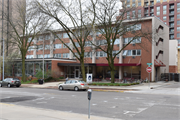Property Record
306 N. Brooks Street
Architecture and History Inventory
| Historic Name: | University YMCA |
|---|---|
| Other Name: | |
| Contributing: | |
| Reference Number: | 241079 |
| Location (Address): | 306 N. Brooks Street |
|---|---|
| County: | Dane |
| City: | Madison |
| Township/Village: | |
| Unincorporated Community: | |
| Town: | |
| Range: | |
| Direction: | |
| Section: | |
| Quarter Section: | |
| Quarter/Quarter Section: |
| Year Built: | 1953 |
|---|---|
| Additions: | |
| Survey Date: | 2019 |
| Historic Use: | recreational building/gymnasium |
| Architectural Style: | Contemporary |
| Structural System: | |
| Wall Material: | Brick |
| Architect: | |
| Other Buildings On Site: | |
| Demolished?: | No |
| Demolished Date: |
| National/State Register Listing Name: | Not listed |
|---|---|
| National Register Listing Date: | |
| State Register Listing Date: |
| Additional Information: | City of Madison, Wisconsin Underrepresented Communities Historic Resource Survey Report: The Women’s Liberation Movement was never monolithic. Even in 1968, the movement nationally was splintering. NOW was the first new national feminist organization in nearly fifty years. They opened the floodgates of a powerful second wave of American feminism by advancing earnest consideration of the issues preventing women’s self-determination. NOW had persuaded a critical mass of Americans that women did not have rights or opportunities equal to men. Women, however, were hardly united in their methods for achieving reforms. A younger cohort of feminists took shape in the late-1960s who regarded the leaders of the movement as too conservative. They took a more revolutionary approach to the movement and adopted radical feminism that called for a new social order in which women would be liberated from unjust, sexist norms. They were also eager to join forces with lesbian feminists in the Gay Liberation movement, a partnership that NOW did not embrace. By 1970, the movement was being described as having two branches: one older and more conservative and the other young, college-educated, and protesting. The reluctance of the conservative branch of the movement (led by NOW) to embrace lesbian feminists manifested in Madison as well. It was a clear point of division between the YMCA and the United Way of Dane County over funding in 1972. In an emblematic move, the women’s center established under the banner of the Women’s Liberation Movement by NOW and the University YMCA at their North Brooks Street building in 1970 was reorganized and relocated by lesbian feminist leaders in 1972. A women’s center was originally established in 1970 at the University YMCA at 306 North Brooks Street by people associated with the National Organization for Women and under the banner of the Women’s Liberation Movement. The center lost funding when the United Way of Dane County declined to provide money to an organization that is perceived as “politically leftist.” In 1972, lesbian feminist leaders raised money for the Center by holding special events at venues coordinated by gay liberation groups: St. Francis House Episcopal Student Center at 1001 University Avenue (now 1011 University Avenue) and the Crossroads Gay Center at 301½ N. Hamilton Street. The availability of counseling was an important component of the Gay Liberation Movement in Madison. In the early 1970s, homosexuality was still listed as a mental illness in the DSM; however, it was removed in 1973. Psychological professionals commonly defended the theory that homosexuality was caused by arrested emotional development, and writers and filmmakers regularly portrayed homosexuals as deviant in popular media. Facing these trends, while also living in a society where discrimination was legal and routine, presented a unique set of emotional burdens for queer people living out their identity. The need for counseling, with peers and professionals, was clear from the beginning of the movement. During the first few years of the Gay Liberation Movement in Madison, the response to this need was informal, consisting of volunteer, peer-run counseling offered by LGBTQ groups. In November 1974, the Lesbian Switchboard opened at the University YMCA at 306 North Brooks Street, a hive of LGBTQ activity in the 1970s and into the 1990s, hosting a variety of social, organizational, therapeutic, and publishing activities by LGBTQ groups with several LGBTQ organizations maintaining office space and publishing newsletters in the building during this time. The Lesbian Switchboard was a collective of para-professional counselors offering connectivity and emotional and social support to lesbians. The Lesbian Switchboard operated a counseling service as a collective with no hierarchy and offered a library of lesbian resources, including information on alternative services in Madison, feminist groups across the country, and other lesbian and gay organizations in the United States. They presented “panel discussions on lesbianism,” and sponsored “lesbian coffee houses, women’s dances, a lesbian newsletter, concerts by women for women, and protests against oppressive groups in the Madison areas.” The Lesbian Switchboard appears to have merged with another LGBTQ organization or disbanded around 1979 when progressive professionals began offering counseling services that recognized the issues commonly faced by LGBTQ people. By December 1978, The United located at the University YMCA at 306 North Brooks Street. After the initial threat passed, The United identified new battles and issues and continued their efforts. The YMCA was a hive of LGBTQ activity from the 1970s into the 1990s, hosting a variety of social, organizational, therapeutic, and publishing activities by LGBTQ groups. Several LGBTQ organizations-maintained office space and published newsletters in the building during this time. |
|---|---|
| Bibliographic References: |
| Wisconsin Architecture and History Inventory, State Historic Preservation Office, Wisconsin Historical Society, Madison, Wisconsin |

